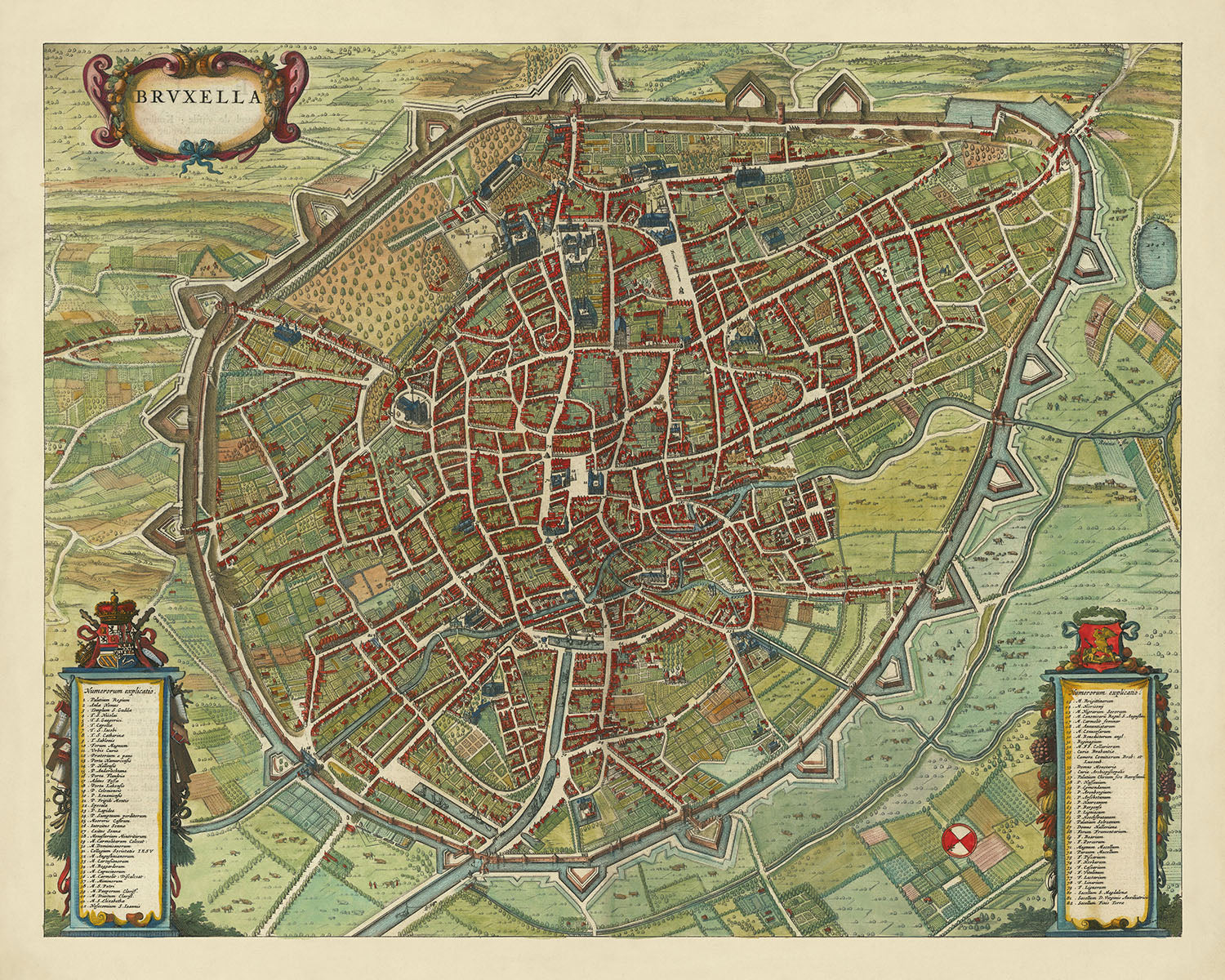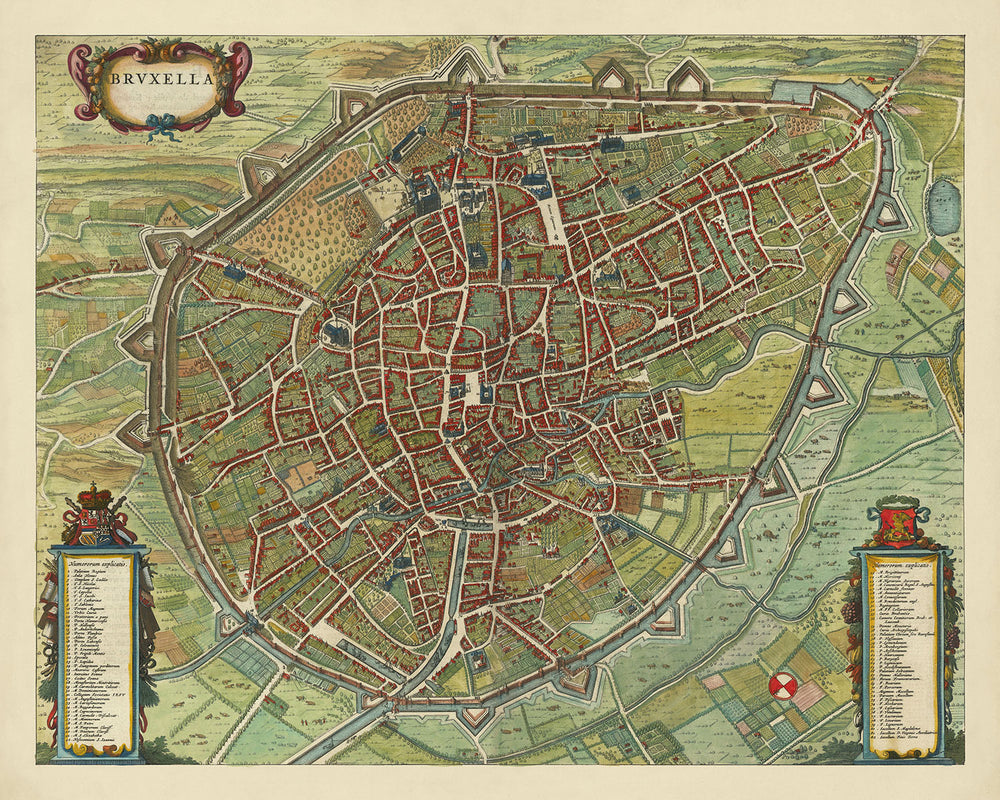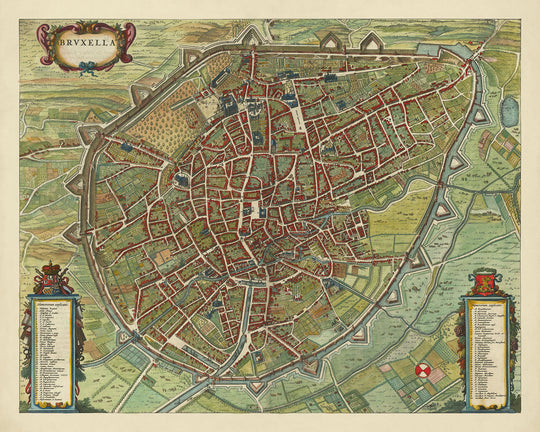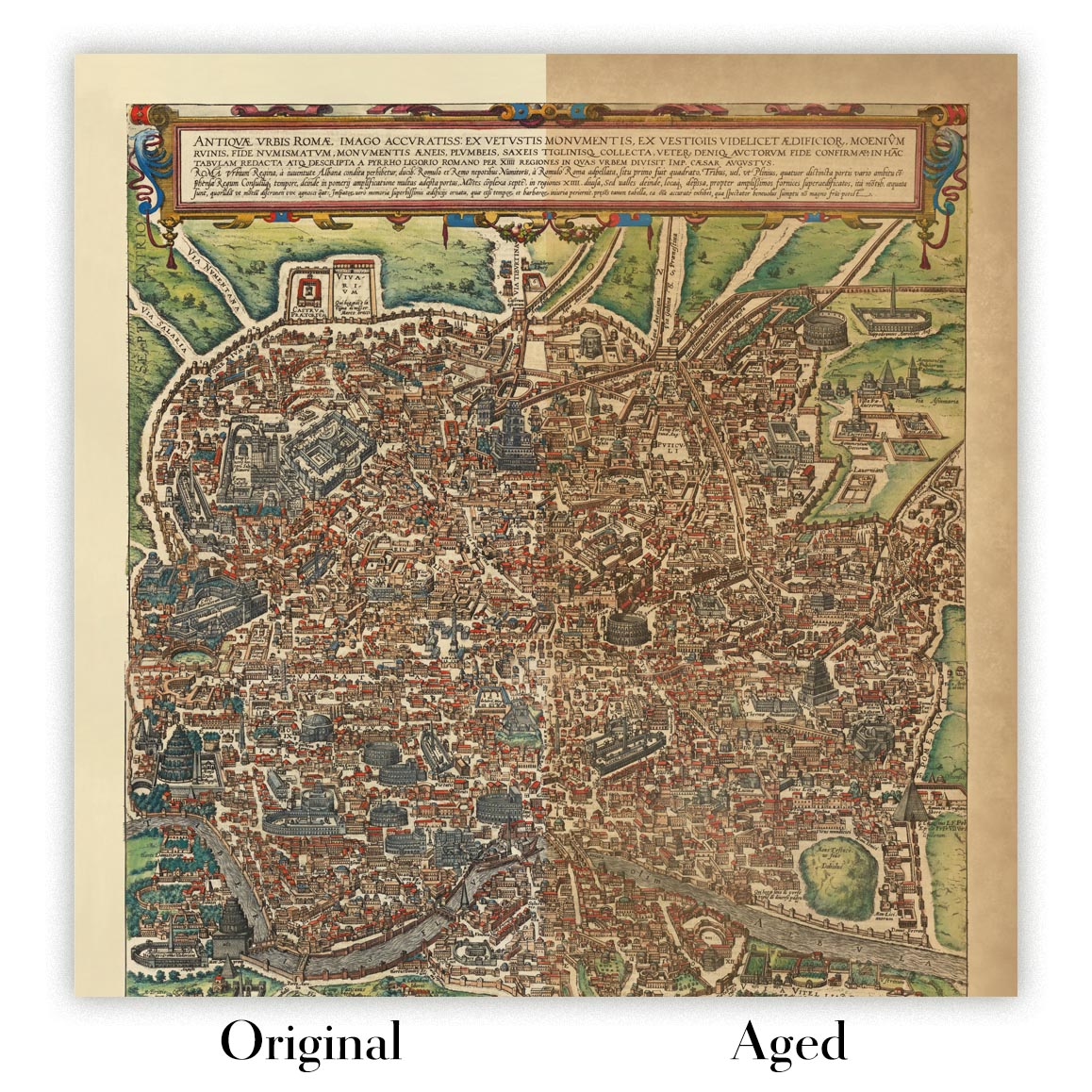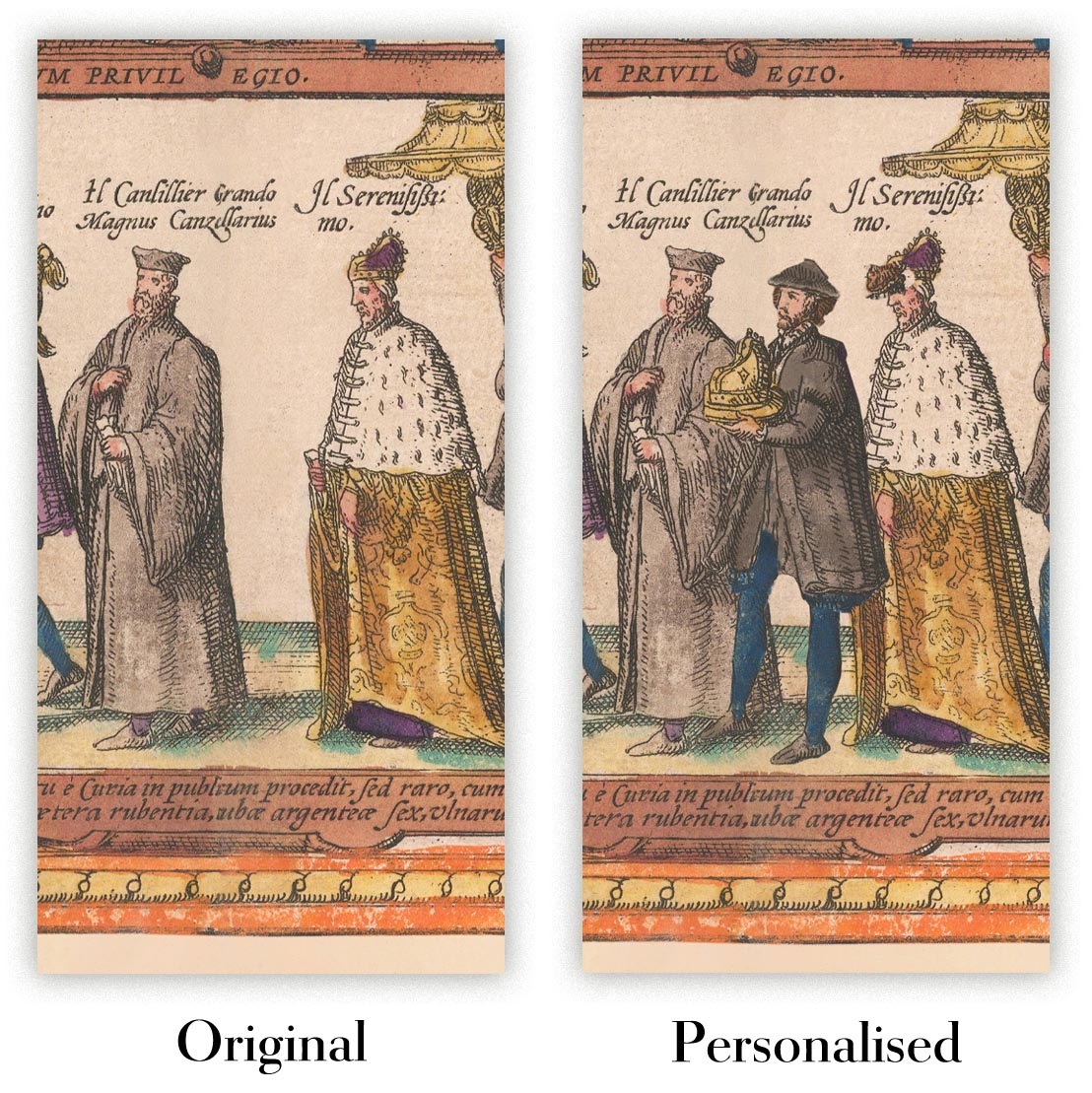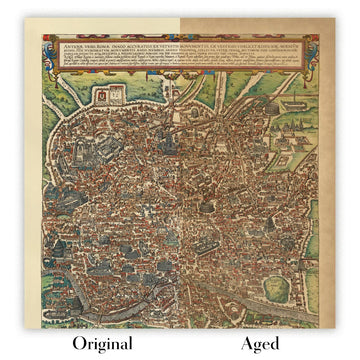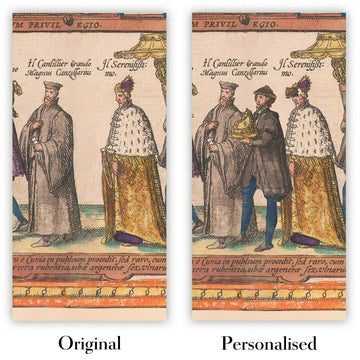- Handmade locally. No import duty or tax
- FREE worldwide delivery
- Love it or your money back (90 days)
- Questions? WhatsApp me any time
Own a piece of history
5,000+ 5 star reviews


Introducing the exquisite "Bruxella," a masterful creation by the renowned cartographer Johannes Blaeu in 1649. This remarkable bird's-eye view map offers a detailed glimpse into mid-17th Century Brussels, encapsulating the city's rich history and architectural grandeur. As part of Blaeu's celebrated "Novum Ac Magnum Theatrum Urbium Belgicae Regiae," this map is a testament to the cartographic brilliance and artistic finesse of the Blaeu family, who were pioneers in the Golden Age of Dutch cartography.
The map of Brussels is surrounded by its fortified walls, a feature that underscores the city's strategic importance and defensive prowess during the 17th century. The fortifications are meticulously illustrated, providing a fascinating insight into the military architecture of the period. Within these walls lies a vibrant cityscape, teeming with over 80 points of interest, each meticulously identified in the accompanying legends. This level of detail makes "Bruxella" not just a map, but a historical document that captures the essence of Brussels in its heyday.
Significant neighborhoods and districts are clearly delineated, offering a window into the urban planning and community structure of historical Brussels. The map showcases the intricate network of streets and roads, each one a pathway through the city's storied past. Notable thoroughfares such as Rue de l'Ecuyer and Rue des Bouchers weave through the map, connecting various quarters and highlighting the bustling activity that characterized the city. These streets, still in existence today, serve as a link between the past and the present, making this map a valuable artifact for both historians and modern-day explorers.
Landmarks and public buildings are prominently featured, providing a sense of the architectural heritage that has shaped Brussels. Churches, public squares, and significant structures are all depicted with an eye for detail that is characteristic of Blaeu's work. The map's decorative elements, including ornate cartouches and coats of arms, add a touch of elegance and grandeur, making it a visual feast for the discerning collector. Each landmark tells a story, contributing to the rich tapestry of Brussels' history.
Surrounding the city, the map illustrates the lush green areas and open spaces that provided respite from the urban hustle. These parks and gardens, along with the rivers and waterways, are depicted with a naturalistic charm that enhances the map's aesthetic appeal. The careful balance between urban and natural elements reflects the harmonious coexistence of city life and nature, a theme that resonates through the centuries. "Bruxella" is not just a map; it is a journey through time, offering a captivating glimpse into the heart of one of Europe's most historic cities.
Streets and roads on this map
- Rue de l'Ecuyer
- Rue de la Montagne
- Rue des Bouchers
- Rue des Dominicains
- Rue des Fripiers
- Rue du Marché aux Herbes
- Rue du Midi
- Rue du Poinçon
- Rue du Pont de la Carpe
- Rue du Sable
- Rue du Vieux Marché aux Grains
- Rue Haute
- Rue Neuve
- Rue Notre Dame de la Chapelle
- Rue Saint-Géry
- Rue Saint-Jean
- Rue Saint-Nicolas
- Rue Sainte-Catherine
- Rue des Tanneurs
- Rue des Teinturiers
- Rue des Ursulines
- Rue du Chêne
- Rue du Fossé aux Loups
- Rue du Grand Hospice
- Rue du Lombard
- Rue du Marché au Charbon
- Rue du Marché aux Poulets
- Rue du Miroir
- Rue du Rempart des Moines
Notable Features & Landmarks
- Illustrations:
- Ornate cartouches and coats of arms.
- Landmarks:
- Various churches, public buildings, and significant structures identified in the legends.
- Neighbourhoods:
- The city is divided into various districts and quarters, visible through the street layout.
- Large parks:
- Green areas surrounding the city, indicating open spaces and gardens.
Historical and design context
- Name of the map: Bruxella
- When the map was made: 1649
- Mapmaker or publisher: Johannes Blaeu
- Interesting context about the mapmaker: Johannes Blaeu was a prominent Dutch cartographer and publisher. He was part of the Blaeu family, known for their high-quality maps and atlases during the Golden Age of Dutch cartography.
- Topics and themes shown on the map:
- Cityscape: A bird's-eye view of Brussels, providing a detailed layout of the city.
- Fortifications: The map shows the fortified walls surrounding Brussels, emphasizing the city's defensive structures.
- Points of Interest: Over 80 notable locations within the city are identified.
- Countries and regions shown on the map: The map focuses on Brussels, which is part of present-day Belgium.
- Design or style of the map:
- Bird's-eye view: The map is a pictorial representation, providing a detailed aerial perspective of the city.
- Decorative elements: The map includes ornate cartouches, coats of arms, and a detailed legend.
- Historical significance or context:
- The map provides valuable insights into the urban layout and architecture of 17th Century Brussels.
- It reflects the cartographic skill and artistic style of the Blaeu family, who were leading figures in mapmaking during the period.
Please double check the images to make sure that a specific town or place is shown on this map. You can also get in touch and ask us to check the map for you.
This map looks great at every size, but I always recommend going for a larger size if you have space. That way you can easily make out all of the details.
This map looks amazing at sizes all the way up to 90in (230cm). If you are looking for a larger map, please get in touch.
The model in the listing images is holding the 16x20in (40x50cm) version of this map.
The fifth listing image shows an example of my map personalisation service.
If you’re looking for something slightly different, check out my collection of the best old maps to see if something else catches your eye.
Please contact me to check if a certain location, landmark or feature is shown on this map.
This would make a wonderful birthday, Christmas, Father's Day, work leaving, anniversary or housewarming gift for someone from the areas covered by this map.
This map is available as a giclée print on acid free archival matte paper, or you can buy it framed. The frame is a nice, simple black frame that suits most aesthetics. Please get in touch if you'd like a different frame colour or material. My frames are glazed with super-clear museum-grade acrylic (perspex/acrylite), which is significantly less reflective than glass, safer, and will always arrive in perfect condition.
This map is also available as a float framed canvas, sometimes known as a shadow gap framed canvas or canvas floater. The map is printed on artist's cotton canvas and then stretched over a handmade box frame. We then "float" the canvas inside a wooden frame, which is available in a range of colours (black, dark brown, oak, antique gold and white). This is a wonderful way to present a map without glazing in front. See some examples of float framed canvas maps and explore the differences between my different finishes.
For something truly unique, this map is also available in "Unique 3D", our trademarked process that dramatically transforms the map so that it has a wonderful sense of depth. We combine the original map with detailed topography and elevation data, so that mountains and the terrain really "pop". For more info and examples of 3D maps, check my Unique 3D page.
For most orders, delivery time is about 3 working days. Personalised and customised products take longer, as I have to do the personalisation and send it to you for approval, which usually takes 1 or 2 days.
Please note that very large framed orders usually take longer to make and deliver.
If you need your order to arrive by a certain date, please contact me before you order so that we can find the best way of making sure you get your order in time.
I print and frame maps and artwork in 23 countries around the world. This means your order will be made locally, which cuts down on delivery time and ensures that it won't be damaged during delivery. You'll never pay customs or import duty, and we'll put less CO2 into the air.
All of my maps and art prints are well packaged and sent in a rugged tube if unframed, or surrounded by foam if framed.
I try to send out all orders within 1 or 2 days of receiving your order, though some products (like face masks, mugs and tote bags) can take longer to make.
If you select Express Delivery at checkout your order we will prioritise your order and send it out by 1-day courier (Fedex, DHL, UPS, Parcelforce).
Next Day delivery is also available in some countries (US, UK, Singapore, UAE) but please try to order early in the day so that we can get it sent out on time.
My standard frame is a gallery style black ash hardwood frame. It is simple and quite modern looking. My standard frame is around 20mm (0.8in) wide.
I use super-clear acrylic (perspex/acrylite) for the frame glass. It's lighter and safer than glass - and it looks better, as the reflectivity is lower.
Six standard frame colours are available for free (black, dark brown, dark grey, oak, white and antique gold). Custom framing and mounting/matting is available if you're looking for something else.
Most maps, art and illustrations are also available as a framed canvas. We use matte (not shiny) cotton canvas, stretch it over a sustainably sourced box wood frame, and then 'float' the piece within a wood frame. The end result is quite beautiful, and there's no glazing to get in the way.
All frames are provided "ready to hang", with either a string or brackets on the back. Very large frames will have heavy duty hanging plates and/or a mounting baton. If you have any questions, please get in touch.
See some examples of my framed maps and framed canvas maps.
Alternatively, I can also supply old maps and artwork on canvas, foam board, cotton rag and other materials.
If you want to frame your map or artwork yourself, please read my size guide first.
My maps are extremely high quality reproductions of original maps.
I source original, rare maps from libraries, auction houses and private collections around the world, restore them at my London workshop, and then use specialist giclée inks and printers to create beautiful maps that look even better than the original.
My maps are printed on acid-free archival matte (not glossy) paper that feels very high quality and almost like card. In technical terms the paper weight/thickness is 10mil/200gsm. It's perfect for framing.
I print with Epson ultrachrome giclée UV fade resistant pigment inks - some of the best inks you can find.
I can also make maps on canvas, cotton rag and other exotic materials.
Learn more about The Unique Maps Co.
Map personalisation
If you're looking for the perfect anniversary or housewarming gift, I can personalise your map to make it truly unique. For example, I can add a short message, or highlight an important location, or add your family's coat of arms.
The options are almost infinite. Please see my map personalisation page for some wonderful examples of what's possible.
To order a personalised map, select "personalise your map" before adding it to your basket.
Get in touch if you're looking for more complex customisations and personalisations.
Map ageing
I have been asked hundreds of times over the years by customers if they could buy a map that looks even older.
Well, now you can, by selecting Aged before you add a map to your basket.
All the product photos you see on this page show the map in its Original form. This is what the map looks like today.
If you select Aged, I will age your map by hand, using a special and unique process developed through years of studying old maps, talking to researchers to understand the chemistry of aging paper, and of course... lots of practice!
If you're unsure, stick to the Original colour of the map. If you want something a bit darker and older looking, go for Aged.
If you are not happy with your order for any reason, contact me and I'll get it fixed ASAP, free of charge. Please see my returns and refund policy for more information.
I am very confident you will like your restored map or art print. I have been doing this since 1984. I'm a 5-star Etsy seller. I have sold tens of thousands of maps and art prints and have over 5,000 real 5-star reviews. My work has been featured in interior design magazines, on the BBC, and on the walls of dozens of 5-star hotels.
I use a unique process to restore maps and artwork that is massively time consuming and labour intensive. Hunting down the original maps and illustrations can take months. I use state of the art and eye-wateringly expensive technology to scan and restore them. As a result, I guarantee my maps and art prints are a cut above the rest. I stand by my products and will always make sure you're 100% happy with what you receive.
Almost all of my maps and art prints look amazing at large sizes (200cm, 6.5ft+) and I can frame and deliver them to you as well, via special oversized courier. Contact me to discuss your specific needs.
Or try searching for something!







